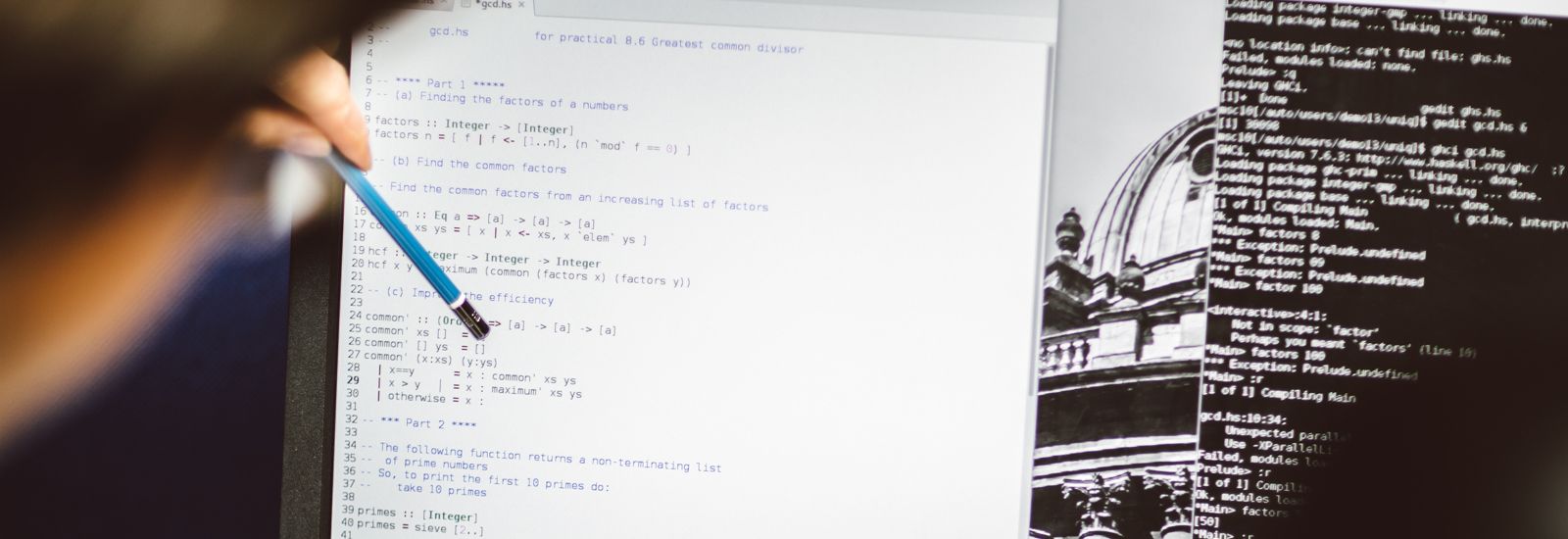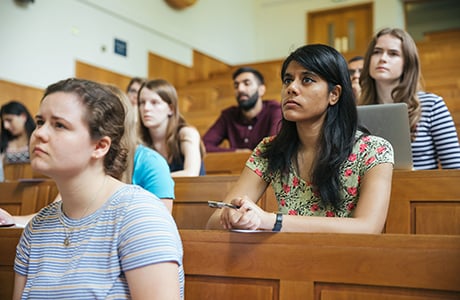How Hard Is It for Mathematics Undergrad to Go to Computer Science Grad School
A Computer Science student. (Credit: Paul Tait) 
Share This
Computer Science
- Overview
- Structure
- Admissions Requirements
- Careers
- Fees and Funding
- Studying at Oxford
3 years (BA) A*AA, with the A* in Maths, Further Maths or Computing/Computer Science Interviewed: 20% +44 (0) 1865 273821 / 283507 Unistats information for this course can be found at the bottom of the page

UCAS code G400 
Duration
4 years (MCompSci) ![]()
Admissions requirements 
Subject requirements Maths
Further Maths 
Admissions test(s) ox.ac.uk/mat 
Written work None 
Admissions statistics*
Successful: 6%
Intake: 41
*3-year average 2018-20 ![]()
Contact
Email Computer Science
Computer science is about understanding computer systems and networks at a deep level. Computers and the programs they run are among the most complex products ever created; designing and using them effectively presents immense challenges. Facing these challenges is the aim of computer science as a practical discipline, and this leads to some fundamental questions:
- How can we capture in a precise way what we want a computer system to do?
- Can we mathematically prove that a computer system does what we want it to?
- How can computers help us to model and investigate complex systems like the Earth's climate, financial systems or our own bodies?
- What are the limits to computing? Will quantum computers extend those limits?
The theories that are now emerging to answer these kinds of questions can be immediately applied to design new computers, programs, networks and systems that are transforming science, business, culture and all other aspects of life.
Computer Science can be studied for three years (BA) or four years (Master of Computer Science). The fourth year allows the study of advanced topics and an in-depth research project. Students do not need to choose between the three-year and four-year options when applying to the course; all students apply for the four-year course, and then decide at the start of the third year whether they wish to continue to the fourth year (which is subject to achieving a 2:1 at the end of the third year).
The course concentrates on creating links between theory and practice. It covers a wide variety of software and hardware technologies and their applications. We are looking for students with strong mathematical ability, which you will develop into skills that can be used both for reasoning rigorously about the behaviour of programs and computer systems, and for applications such as scientific computing. You will also gain practical problem-solving and program design skills; the majority of subjects within the course are linked with practical work in our well-equipped laboratory.
 | 'I love many things about my course. I love the fact that it's hard, that it's very theoretical and that we get a lot of practical work. Even when the work is a little challenging you're never lost because there are so many people around to help you. The tutors really support you at every step and this motivates you to do well. KAMIL |
A typical week
During the first part of the course, your work will be divided between about ten lectures and two tutorials each week, in addition to about two practical sessions. In tutorials you will discuss ideas in depth with an experienced computer scientist, usually with just one or two other students. You will be expected to spend a considerable amount of time developing your own understanding of the topics covered in lectures, answering questions designed to check your understanding, and preparing for tutorials.
As the course progresses, you will also begin to work in small classes of up to ten people on more specialised topics. In the second year you will take part in a group design practical, which may be sponsored by industry. In Years 3 and 4 about a third of your time is spent working on your chosen individual project. Most tutorials, classes, and lectures are delivered by staff who are tutors in their subject. Many are world-leading experts with years of experience in teaching and research. Some teaching may also be delivered by postdoctoral researchers or postgraduate students who are studying at doctorate level.
To find out more about how our teaching year is structured, visit our Academic Year page.
Course structure
| YEAR 1 | |
| COURSES
| ASSESSMENT Four exam papers |
| YEAR 2 | |
| COURSES
| ASSESSMENT Eight exam papers |
| YEAR 3 | |
| COURSES
| ASSESSMENT Six exam papers plus project report |
| YEAR 4 | |
| COURSES
The courses listed above are illustrative and may change. A full list of current options is available on the Computer Science website. | ASSESSMENT Five take-home exams or written papers plus project report |
Academic requirements
| A-levels: | A*AA including at least an A in Mathematics, with the A* in Mathematics, Further Mathematics or Computing/Computer Science. Those taking Further Mathematics A-level or AS-level are expected to achieve at least Grade A. |
| Advanced Highers: | AA/AAB with an A in Mathematics |
| IB: | 39 (including core points) with 766 at HL (the 7 must be in HL Mathematics) |
| BTEC: | For students taking the BTEC National Extended Diploma in IT, a conditional offer will normally be: DDD in the Extended Diploma and A* in A-level Maths. Students taking BTEC National Extended Diplomas in science or engineering, or the new T-level qualifications, will also be considered, but the above requirement for A-level Maths still stands. |
| Or any other equivalent (see other UK qualifications, and international qualifications) | |
Wherever possible, your grades are considered in the context in which they have been achieved. (See further information on how we use contextual data.)
Subject requirements
| Essential: | Candidates are expected to have Mathematics to A-level (A* or A grade), Advanced Higher (A grade), Higher Level in the IB (score 7) or another equivalent. |
| Recommended: | Further Mathematics is highly recommended.* Those taking Further Mathematics A-level or AS-level are expected to achieve at least Grade A. |
*If your school offers Further Maths A-Level we expect you to have taken it. However, we understand that not all schools offer Further Maths, and so we do consider applications from people with a single Maths A-level. If you are based in England, and your school doesn't offer Further Maths please see the Advanced Mathematics Support Programme website as they can provide extra maths support. In Wales, see the Further Mathematics Support Programme Wales.
Please note from 2018-20, 97% of A-level students who were offered places for Computer Science courses (including joint courses) took Further Maths to A-level.
Applying
All candidates must follow the application procedure as shown in applying to Oxford. The information below gives specific details for students applying for this course. For more information on how to apply, including advice on interviews, specimen MAT papers, and sample questions, please see the Computer Science department website.
Admissions test
| Test: | MAT |
| Test date: | 3 November 2021 |
| Registration deadline: | 6pm 15 October 2021 |
All candidates must take the Mathematics Admissions Test (MAT) as part of their application. Separate registration for this test is required and it is the responsibility of the candidate to ensure that they are registered. We strongly recommend making the arrangements in plenty of time before the deadline. Everything you need to know, including guidance on how to prepare, can be found on the MAT page.
Written work
You do not need to submit any written work when you apply for this course.
What are tutors looking for?
We look for proven mathematical talent, the ability to think and work independently, the capacity to absorb and use new ideas, and enthusiasm. We use these criteria alongside the Mathematics Admissions Test (MAT) results to decide whom to interview. At interview, we explore how you tackle unfamiliar problems and respond to new ideas; we are more interested in how you approach problem-solving than the solution. We don't require any previous formal qualification in computing, but we do expect a real interest in the subject.
For more detail on the selection criteria for this course, please see the Computer Science website.
Careers
Common roles for graduates include computer programmer, software designer and engineer, financial analyst and scientific researcher. Graduates in Computer Science from Oxford were the top earners in the 2017 Sunday Times league table of graduate salaries. Six months after graduation our students had achieved a median salary of £45,000, higher than graduates of all other UK undergraduate degree courses.
Fees
Additional Fees and Charges Information for Computer Science
There are no compulsory costs for this course beyond the fees shown above and your living costs.
How Hard Is It for Mathematics Undergrad to Go to Computer Science Grad School
Source: https://www.ox.ac.uk/admissions/undergraduate/courses-listing/computer-science
0 Response to "How Hard Is It for Mathematics Undergrad to Go to Computer Science Grad School"
Post a Comment